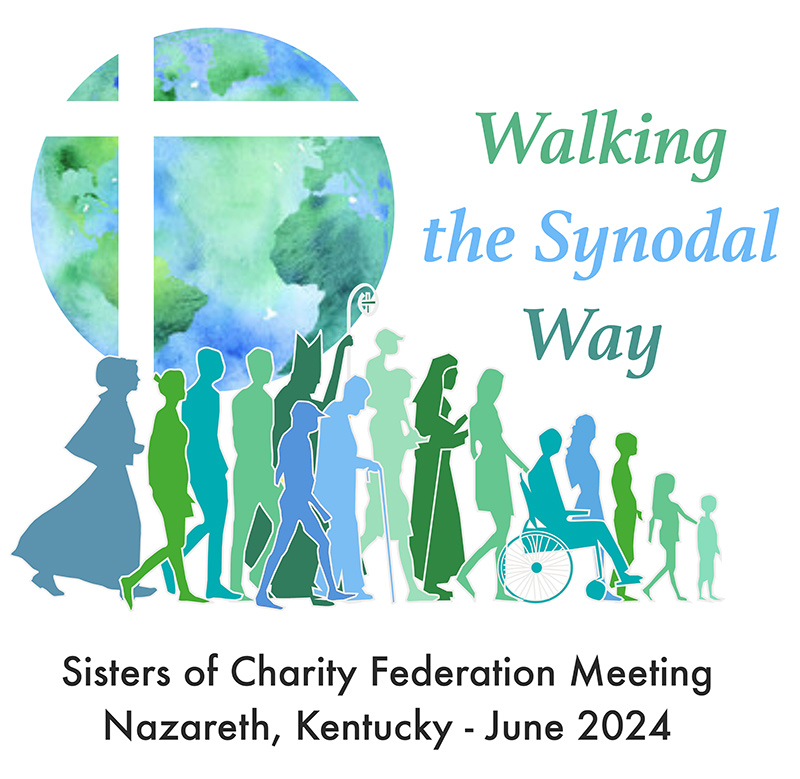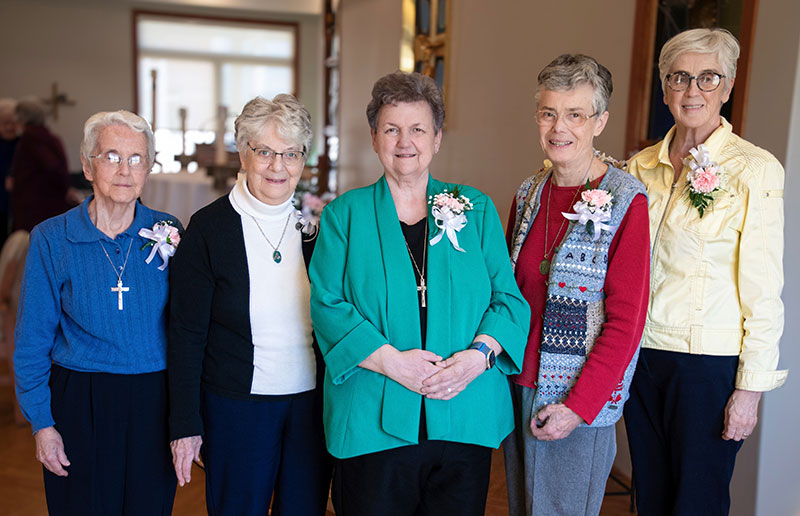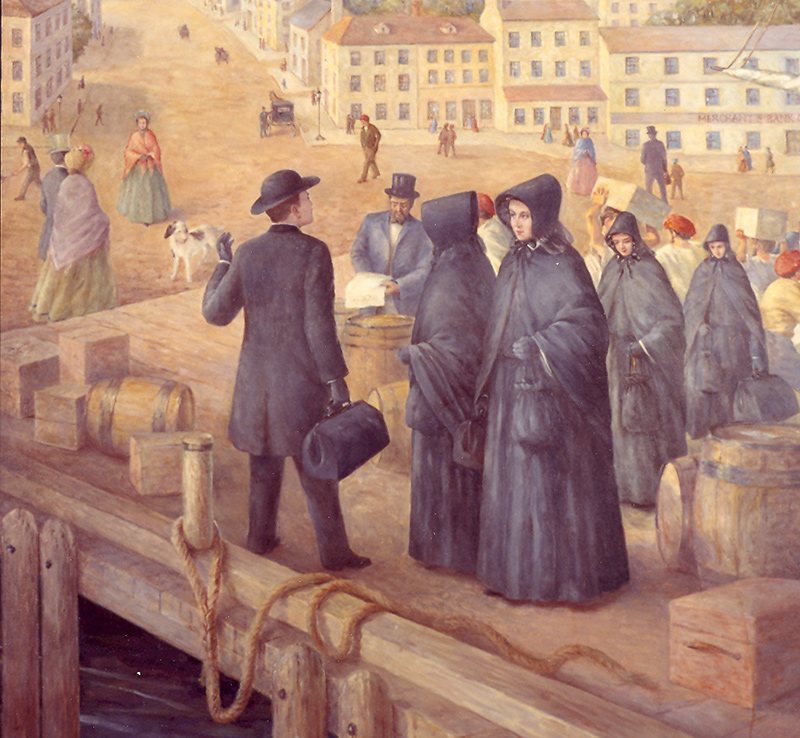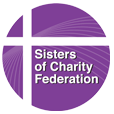Federation History
Federation Formation
The apostolic delegate to the United States, Amleto Giovanni Cardinal Cicognani (1883-1973), recommended that the spiritual daughters of Elizabeth Bayley Seton collaborate to further the cause for canonization of this convert, who was a wife, mother, widow, sole parent, foundress, and spiritual leader. Despite growth pains, the Sisters of Charity of St. Joseph's, incorporated in 1817 in Maryland, continued to develop and blossom into independent new congregations in North America: New York (1846), Cincinnati (1852), Halifax (1856), Convent Station (1859), and Greensburg (1870). The conflict-ridden circumstances surrounding the initial separations from Emmitsburg were a source of pain for all involved, especially after French émigré priests belonging to the Society of Saint Sulpice (Sulpicians) of Baltimore arranged for the Sisters of Charity of Saint Joseph’s to join (1850) the Company of the Daughters of Charity of Saint Vincent de Paul (D.C.) of Paris, France.
The mistresses of initial formation were the first group invited to convene through the Federation (1966). This led to the ongoing discussion about formation practices and sponsorship of formation programs (1985), The Roots Program (1986), Roots on-the-Road (1987), Roots Revisited, and a final vow retreat (1989). Later the Sisters of Charity of New York and the Sisters of Charity of Saint Elizabeth established a joint novitiate (1990) which became (1992) a collaborative novitiate with the additional involvement of the Sisters of Charity of Seton Hill, the New York and Boston Provinces of the Sisters of Charity of Halifax, and later other Federation members. An annual gathering of formators evolved (1989) into the Company of Charity Formation Personnel (CCFP), which affiliated (1992) with the Federation as a formal sub-group.
Members focused on the Seton legacy of education as a springboard for exploring collaborative possibilities through annual conferences of Setonian colleges (1967). The Federation also used special anniversaries to promote Seton celebrations in conjunction with the bicentennial year of the birth of Elizabeth Ann Seton (1974), and the bicentennial of the United States (1976).
The Federation focused almost exclusively on promoting the Cause of Elizabeth Bayley Seton for sainthood until 1975. The Seton cause was introduced in Rome in 1940. Blessed John XXIII declared Mother Seton venerable December 18, 1959, and also presided at her beatification March 17, 1963. Pope Paul VI canonized her as Saint Elizabeth Ann Seton September 14 during the Holy Year of 1975 and the International Year of the Woman.
After their successful collaboration on the Cause for canonization, the Federation focused on joint projects related to charism, formation, and mission. Member congregations explored the triadic base of renewal recommended by Vatican II–the Gospel, the signs of the times, and the original spirit of the founders–and came to a new awareness of and appreciation for their shared heritage and stewardship responsibility for the Vincentian and Setonian charism expressed through the Tradition of Charity (Cf. Perfectae Caritatis, §1-2).
Among its earliest intercongregational projects were a newsletter, observances of the feast of Blessed Elizabeth Ann Seton, special gatherings at professional meetings, and the publication of reports related to social justice advocacy and local ministries among persons oppressed by poverty. Members assisted the Mother Seton Guild with public relations and promotion of the Seton cause (1969) and served as docents at the Seton Shrine in Emmitsburg. Members also launched drives to seek approval for a Seton stamp from the Citizens Stamp Advisory Committee of the United States Postal Service (1977). Representatives gathered informally as Charity Connections to share reflections and to write occasional essays on the charism, later published (1988) in booklet format, Living the Charity Charism.
The Federation has also undertaken some major publication projects. Sister Hildegarde Marie Mahoney, S.C. (New Jersey), was commissioned in 1991 to prepare a manuscript on the history of the Federation, but failing eyesight necessitated her withdrawal from the project. Sister Geraldine Anthony, S.C. (Halifax), completed A Vision of Service (Sheed & Ward, 1997), which was published during the fiftieth anniversary of the Federation.
In order to make the writings of Saint Elizabeth Ann Seton more available, the Federation appointed (1996) Sister Regina Bechtle, SC (New York), and Sister Judith Metz, SC (Cincinnati), as co-editors for the publication of the corpus of the Seton papers found in numerous archives in the United States and Canada. Ellin M. Kelly, Ph.D., transcribed these documents and served as the manuscript editor along with Federation representatives who comprised an Advisory Committee for the three-volume work, Elizabeth Bayley Seton Collected Writings (New City Press, 2000).
During the annual meetings of the Federation, members considered strategies to make their shared charism more effective in the modern world, especially in the areas of social justice, spirituality, and renewal programs (1974). Members explored the feasibility of common study of the charism which led them to adopt a resolution (1977) to encourage each community in the Federation to engage in ongoing study, reflection, and sharing of the lives of Vincent de Paul, Louise de Marillac, and Elizabeth Bayley Seton. One result was the initiation (1988) of Charity: A Shared Vision, an ongoing formation program. A later outcome was the first of several scholarly symposia to explore the historical and theological relevance of The Seton Legacy (1992). The Vincentian Studies Institute collaborated with the Federation and published the proceedings of the symposia and annotated listings, by repository, of the writings of Elizabeth Bayley Seton in The Vincentian Heritage. The Federation launched (1999) a new project Charity 2000 & Beyond to provide another series of ongoing formation opportunities.
Federation members desired to forge links with other groups in the Vincentian Family and appointed (1969) Sister Mathilde Comstock, DC, (1901-1997) and later (1984) Sister Rosemary Fleming, SC (Greensburg), as the official representatives of the group to serve on the national board of the Ladies of Charity of the United States. The Ladies of Charity, begun in Paris (1634), developed from the first foundation by Vincent de Paul at Châtillon-les-Dombes, France (1617). Louise de Marillac was actively involved with the Ladies of Charity from which the Daughters of Charity developed. Over time an awareness of the extended Vincentian Family evolved along with the Federation’s desire to strengthen intercongregational networking and collaboration. Sister Theresa Capria, SC (New York), represented the Federation at the 1998 General Assembly of the Congregation of the Mission in Rome.
Federation members committed themselves to seek effective strategies for human development, to promote investment in minority enterprises, and to make corporate responses to social justice issues as early as 1973. Subsequently, members sought ways to study unmet human needs and resources (1979) with the goal of coordinating and networking among already existing ministries which respond to neighbors in need (1987). In order to be more effective advocates on peace and justice issues, the Federation gained recognition as a Non-Governmental Organization (NGO) at the United Nations in 1997. Sister Maria Elena Dio, SC (Halifax), was the first representative of the Federation to the Department of Public Information at the United Nations.
Recent News
-

-
 Sisters of St. Martha of Antigonish announce new leaders Posted on April 25, 2024
Sisters of St. Martha of Antigonish announce new leaders Posted on April 25, 2024 -
 Sisters of Charity – Halifax celebrate 175 years Posted on April 16, 2024
Sisters of Charity – Halifax celebrate 175 years Posted on April 16, 2024
Post Tags
Post Categories
- Annual Meeting (9)
- Daughters of Charity of St Vincent de Paul (61)
- House of Charity (10)
- Les Religieuses de Notre-Dame-du-Sacré-Coeur (36)
- LSAP Care of the Earth (6)
- News (256)
- NGO News (29)
- Sisters of Charity Halifax (53)
- Sisters of Charity of Cincinnati (69)
- Sisters of Charity of Leavenworth (64)
- Sisters of Charity of Nazareth (51)
- Sisters of Charity of New York (53)
- Sisters of Charity of Our Lady of Mercy (32)
- Sisters of Charity of Saint Elizabeth (48)
- Sisters of Charity of Seton Hill (51)
- Sisters of Charity of the Immaculate Conception (37)
- Sisters of St Martha (43)
- Sisters of St Martha of PEI (23)
- Vincentian Family (7)
